
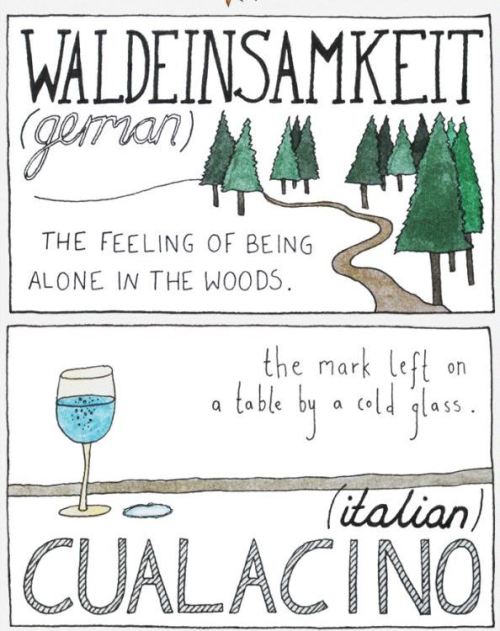
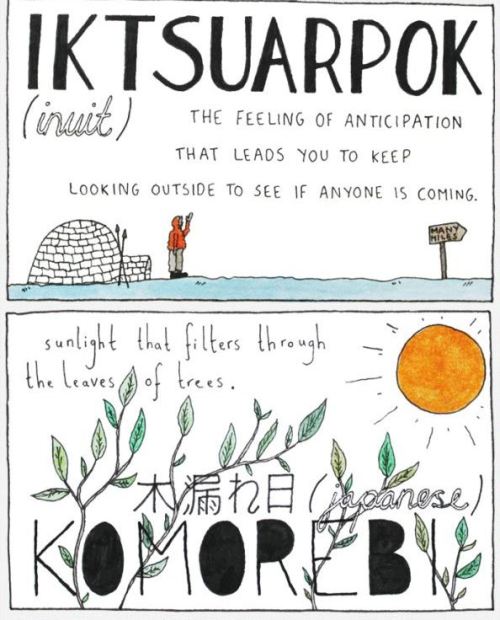
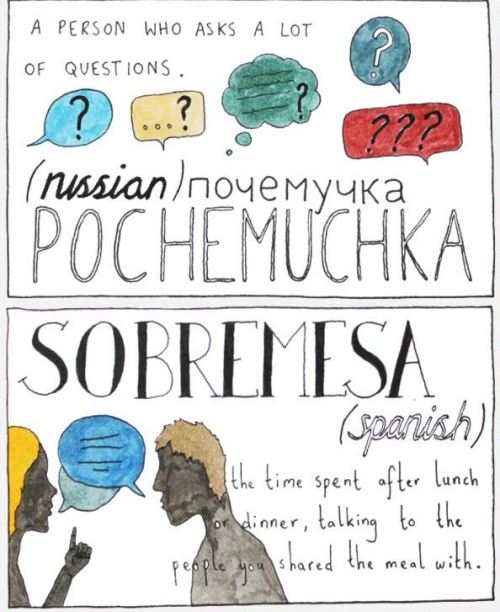
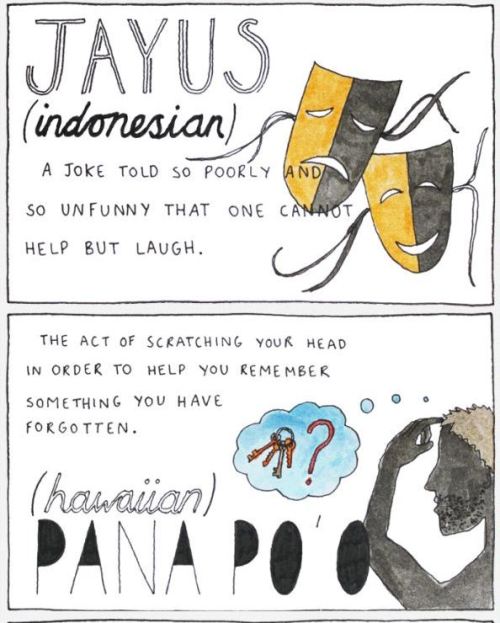
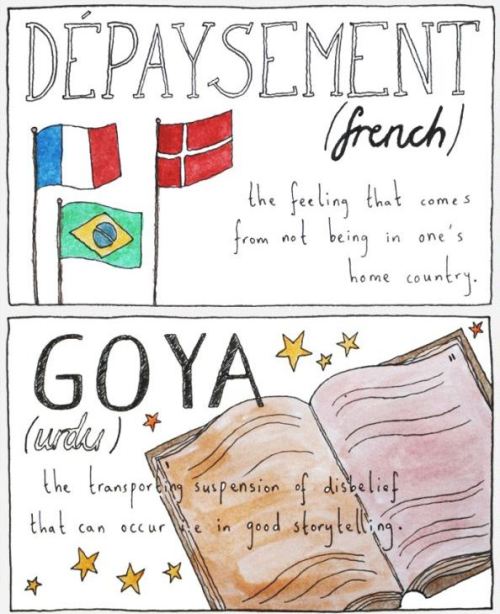
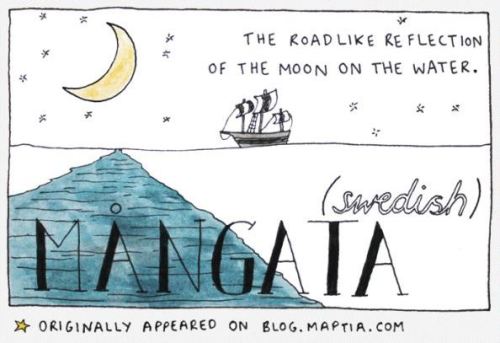
11 Untranslatable Words From Other Cultures
Follow the link for the source
Words
Kristin JosephsonGames! Anyone tried any of these?
It’s no secret that I’m a big fan of playing board games. A good board game can be played hundreds of times and fill countless evenings with family and friends. A good board game can make you think and make you laugh. A good board game makes a great gift, too, and they can often be found at a pretty nice price if you’re patient and wait for sales.
Readers often write to me with mailbag questions related to boardgames, particularly focusing on how to start a board game night. The first step, of course, is to have a good but straightforward and, ideally, inexpensive game. Here are seven such choices (beyond the many games you can play with an ordinary deck of playing cards, of course).
Forbidden Island
$14.94 at Amazon.com
Cooperative island exploration game
30 minutes to play, 1 to 4 players
Similar, but with a bit more depth/complexity: Pandemic (both involve cooperative play)
In Forbidden Island, each player is an explorer of an island, which is represented on the table by a set of double-sided tiles. Hidden on this island are four treasures. Your goal is to find the treasures and get off the island, and each turn you can make a certain number of moves to try to do this. One problem, though: random sections of the island are sinking, so you may have to use your moves to shore up the sinking areas and make sure there’s still paths to the treasure. As time goes on, the island sinks faster and faster.
The game is cooperative, meaning all players are working together to try to defeat the scenario, and the setup is randomized with different difficulty levels. It has very nice components and comes in a nice tin to boot. This makes a good choice for a couple, a pair of couples, or a small family (up to four adults and children).
The Resistance
$14.99 at Amazon.com
Deductive social game with a mild sci-fi theme
15 minutes to play, 5 to 10 players
Similar, but with a bit more depth/complexity: Battlestar Galactica (both involve hidden roles and a sci-fi theme)
In The Resistance, each player receives a secret card at the beginning of the game. Most of the cards are blue, meaning you’re trying to work together to win the game. A few of them are red, which means you’re trying to secretly undermine the other player’s efforts. The game is played through secret cardplay using a very clever and simple ruleset that allows clever blue players to guarantee mission success and clever red players to undermine the missions.
This game is semi-cooperative, as you might imagine, and it plays very quickly and is easy to teach. This works well for larger groups, as you might imagine with five as the minimum number of players.
Battle Line
$17.83 at Amazon
Poker-like set collection game
30 minutes to play, two players
Similar, but with a bit more depth/complexity: Ticket to Ride (both involve set collection)
In Battle Line, two players sit across from each other with a line of nine flags between them. The goal for each player is to either capture five of those flags or three flags in a row. You have a hand of seven cards (the cards are rather similar to ordinary playing cards). On your turn, you play one of those cards on your side of any of the nine flags, then draw a card to replace it. To capture a flag, you have to assemble a better three card poker hand at that flag than your opponent has at the same flag.
This game is fast playing and very easy to teach, but it requires a lot of thought. It’s a wonderful two player game for a couple looking to dip their toes into playing games and want something a little deeper than rummy.
Citadels
$19.95 at Amazon.com
A multiplayer game of intrigue and hidden roles
60 minutes to play, 2 to 8 players
Similar, but with a bit more depth/complexity: 7 Wonders (both involve card drafting)
The heart of Citadels is the role cards. The game comes with a set of eight role cards that each have a number and describe a particular in-game ability (including the ability to “assassinate” another role). Each round, the starting player takes this stack of role cards, randomly puts one of them face down on the table, then chooses from the remainder. He passes the rest to the person on his left and the cards go around the table until everyone has a role, with the final card (or two) placed face down on the table next to the first one. Numbers are then called out in order, with the player having the role card with that number revealing it, using that ability, and playing their turn.
The game is a little complex, but the intrigue and guessing from the role cards makes Citadels into an amazing experience. This is a great group game that I find enjoyable with any group of four to seven or eight players that are at least ten years old or so.
No Thanks!
$9.95 at Amazon.com
A straightforward press-your-luck auction game
15 minutes to play, 2 to 5 players
Similar, but with a bit more depth/complexity: Ra (both involve auctions)
No Thanks! comes with a deck of cards numbered 3 to 35 and a pile of chips. At the start, each player has eleven chips. One of the cards is in the center of the table and, on your turn, you can choose to put a chip on that card or take the card (and all of the chips that have been placed on it). Your goal is to accumulate the fewest points in cards, but when cards form a straight (say, 13, 14, 15, and 16), you only count the lowest card in that straight. So, the goal is to build the smallest possible number of straights. At the end of the game, you count up the value of your cards and straights, subtract the number of chips you have left, and the person with the lowest total wins!
This game is wonderfully light and straightforward, perfect for a light game with friends or family. There’s just enough risk taking and clever choices to keep it interesting, while the rules make sure the game stays very simple.
Love Letter
$10.85 at Amazon.com
A straightforward deduction game
15 minutes to play, 2 to 4 players
Similar, but with a bit more depth/complexity: Sleuth (both are deduction games)
Love Letter is a tiny game – just sixteen special cards and a handful of cubes. When you play the game, you shuffle the sixteen cards and give one to each player. On your turn, you draw a card from the remaining cards and play one of the two in your hand. The cards have varying abilities, but mostly they eliminate other players based on the single card they’re holding. If you’re the last person standing, you get a cube, then you reshuffle the cards and play again. The first person to get a set number of cubes is the winner.
This game is also very light and enjoyable. It’s very tiny, meaning it fits great in a pocket, and it can be taught in just a moment or so. Even so, there’s a lot of deduction and bluffing involved in playing it well.
Coup
Currently out of print, but should return later this year with a price around $15
A clever card game of bluffing and deception
20 minutes to play, three to five players
Similar, but with a bit more depth/complexity: Cosmic Encounter (both involve hidden roles and bluffing)
Much like Love Letter, Coup is a tiny game – it consists of just fifteen cards and a handful of chips. At the start of the game, each player receives two cards face down. On those cards (which remain face down for the whole game) you’ll find a single role, such as Merchant or Assassin. Each player takes a turn in which they can either just take chips (which are money in this game), use the chips to attack another player, or use the ability of their role. Here’s the trick – you can blatantly lie about what role you have. If another player calls you on it and you’re lying, you lose one of your cards. If you’re not lying and you’ve been called, you lose one of your cards. The last person standing with at least one face down card is the winner.
This is a great game of bluffing and deception with some deduction involved as well. If you like a lot of bluffing and some good stories to tell from your games, give this one a try.
The post Seven Wonderful Inexpensive Board Games for a Game Night (or Three) with Family and Friends appeared first on The Simple Dollar.
Kristin Josephsonawwwww.
Letter I embarks on a journey in this clever animated short film, Missing U, a Ringling College of Art and Design senior thesis by Brooke Wagstaff.
Visit more islands and watch more videos about letters.
via Kuriositas.
Kristin Josephsonfor Philly
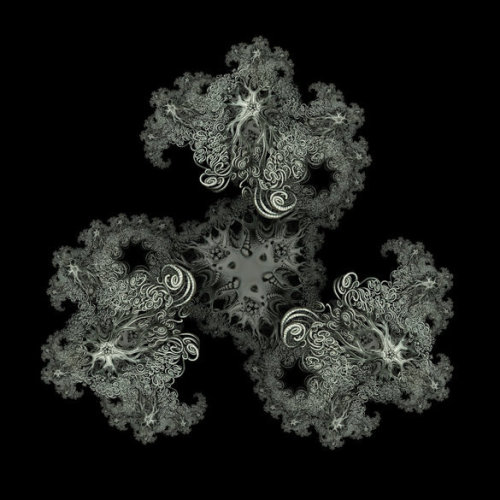
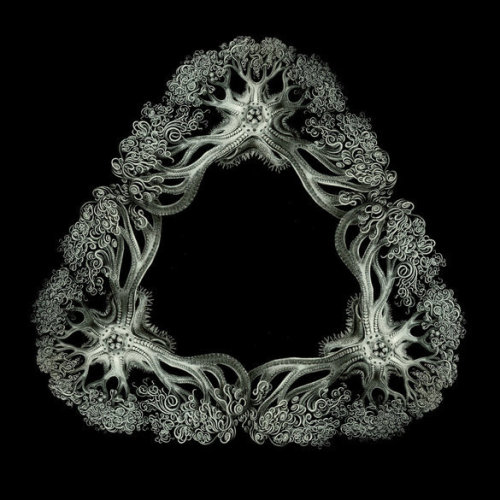

via visualizingmath:
Fractal Generator Art by Tom Beddard
All three of these fractals were created using a fractal generator. They were inspired by German biologist Ernst Haeckel’s famous biology book Artforms of Nature. In particular, these fractals were based on Haeckel’s artwork Astrophyton darwinium.
These fractals show that mathematics and biology can make a very stunning combination!
Haeckel yes.
If you’re new to the classic illustrations that inspired these, you’re in for a treat. Check the links above.
Kristin JosephsonOooh, robots.
On a state-of-the-art assembly line in Fremont, California, 400 cars a day are being created by 3,000 workers and 160 robots. This is Tesla Motors, and the cars they’re making are currently the most advanced electric car on the market. Plus, you know, their factory has giant robot arms installing batteries, motors, seats, windshields, cabling, and components with a delicate ease you might not expect from a giant robot arm.

Wired gives us a tour of the 5-million-square-foot factory where the Tesla Model S is made.
via Kottke.
There are more factories and more cars in the archives.
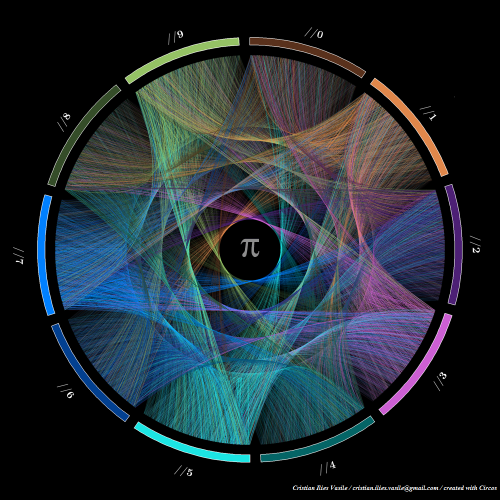
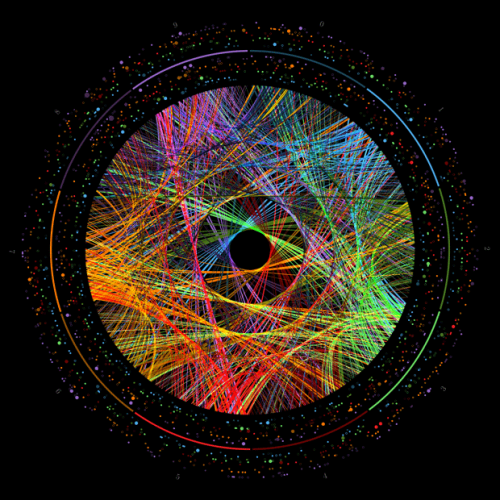
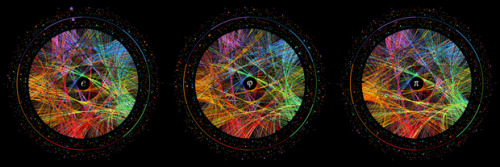
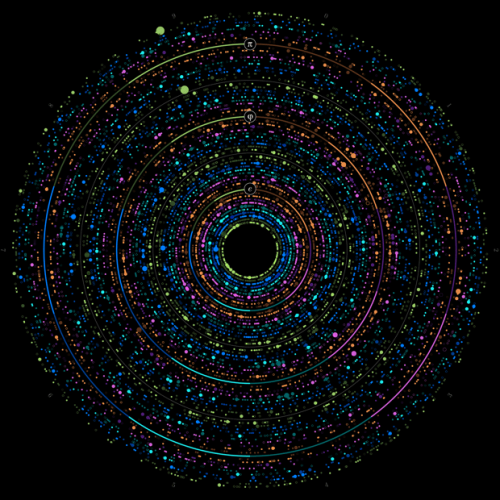

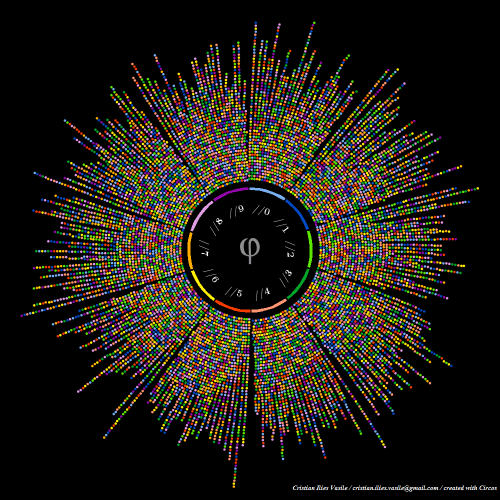
Visualizing the Infinite Beauty of Pi and Other Numbers
Math and art may appear, superficially, like two disparate fields, but they’ve been in conversation for millennia. One recent example of the synergistic possibilities between the two comes from Canadian scientists Christian Ilies Vasile and Martin Kryzwinski. The pair have utilized the data visualization software Circos to create beautiful and colorful visual representations of mathematical constants π (pi), φ (phi), and eusing transition probabilities and color-coded digits on Archimedean spirals.
Given the endless nature of π, φ andethe task of representing them visually in a simplified form could seem daunting. However, thanks to new infographic technology and the natural form of the Archimedean spiral understanding pi’s sequencing (for the layperson anyway) becomes a thing of beauty rather than outright confusion—the technicolored vastness evoking an almost spiritual quality.
For the technical deets on how the pair created the visuals, check out the project page on Kryzwinski’s site.
Photos shown:
- Progression of the first 10,000 digits of π By Cristian Ilies Vasile.
- Progression and transition for the first 1,000 digits of e.
- Progression and transition for the first 1,000 digits of π, φ and e.
- Progression and transition for the first 2,000 digits of e.
- Progression and transition for the first 1,000 digits of the accidental similarity number.
- Progression and transition for the first 1,000 digits of φ.
Numbers like π (pi), φ (phi), and e are inherently free of patterns.
As a quantity to themselves, they represent a specific, finite relationship between two measurements, such as the ratio of a circle’s circumference to its diameter. Yet, pull on the thread and those numerical tapestries unravel into an irrational soup of nonrepeating chaos, a true example of randomness.
That doesn’t mean they don’t make great visualizations, though. Christian Ilies Vasile and Martin Kryzwinski converted these numbers into the beautiful representations above.
The techniques are a little complicated, but the ones with lines bascially represent pairs of digits as they are found next to each other, the ones with various sized dots show how often digits are found next to each other, and the bead-like rosettes represent pairs of digits with an additional coordinate based on their order (so some out-of-order order).
You really don’t want to miss their Archimedean spiral, either:
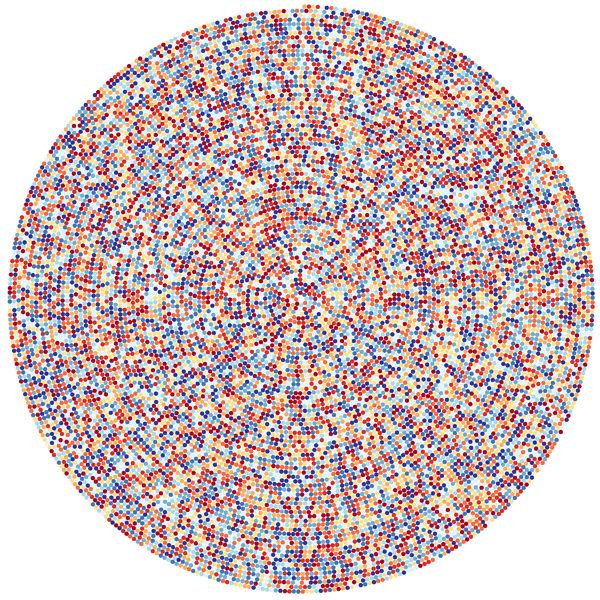
To dig in to the tech a little more, visit their website. This kind of thing is readily doable with today’s software, so get crackin’!
(Via The Creators Project and myampgoesto11)
Kristin JosephsonSo Cool!
Washing Your Hair on the Space Station
Expedition 36 astronaut Karen Nyberg has a unique challenge in space that Chris Hadfield didn’t have to deal with.
She’s got long hair, and lots of it.
Here she explains how she washes her goldy locks in space. It’s not that different from how you might wash your hair on Earth, only with much less water and no elegant, tropical essence créme conditioner.
Even though they have water recycling systems on the ISS (yes, they drink recycled urine), water is a limited resource on the ISS. That means no “Rinse, Repeat". As she explains, all those escaped globs of liquid will be sucked up and recycled, too.
The science they do in space is awesome, but the modified routines of daily life might be even cooler.
I would be remiss if I did not include the following image:

(by insideISS)
Kristin Josephsoncool video. If you click through, check out the cat physics video by "Smarter Every Day"... so cool!

via science-junkie:
Prince Rupert’s drop
The prince Rupert’s drop is a truly amazing thing.When molten glass hits cold water, its outer surface cools rapidly and shrinks as it solidifies. Since the center is still fluid, it can flow to adjust to the outer shell’s smaller size. As that center eventually cools and solidifies, it also shrinks, but now the outer shell is already solid and can’t change its shape to accommodate the smaller core. The result of this is a high amount of internal pressure, as the inside pulls the outside from all directions the glass is set to release a lot of energy. If you break the thin glass at the tail, a chain reaction travels like a shock wave through the drop. As each section breaks, it releases enough energy to break the next section, and so on, shattering the whole drop in less than a millisecond. At the same time The glass can be extremely strong aswell glass breaks when tiny scratches pull apart and spread into fractures. Since the surface is compressed by internal stress, scratches can’t grow, and the glass is very difficult to break.
Credits: ScienceCubed - http://sciencecubed.tumblr.com/
People, if you haven’t seen Destin from Smarter Every Day shatter these things at 130,000 frames per second, you haven’t truly lived.
San Francisco is my favorite city in the world, and living here has helped me become fully vegan (Eva too, as of last year!).
I thought I’d share a (non-comprehensive) list of places to try for fellow vegans visiting the city. It’s the result of my exploration of many places, good and great, which has been admittedly a lot of fun.
You won’t get to all of these, so I’ve marked my favorites. (Update: Here’s a map of these spots, created by reader Ivana.)
Restaurants with only vegan food:
These restaurants serve no meat and are great places for vegans:
You’ll find a ton of places in San Francisco that are vegan friendly (almost every place but steakhouses), but here are some that I like:
Some great places in Berkeley and Oakland (not a complete list):
OK, let’s put my faves together with my favorite spots in San Francisco into a 2-day highlights tour. Warning: It’s not necessarily the healthiest of tours, but you’ll burn it off exploring the city! Map out this stuff before you come to SF.
Other good ideas: Encuentro in Oakland, Rainbow Grocery if you want to buy some food to cook yourself, the Golden Gate Bridge and trails along the coast in Presidio, Land’s End trails, a house-made veggie burger and sweet potato fries at Roam Artisan Burger, Flacos or Cafe Gratitude in Berkeley.
Kristin JosephsonExcellent animation (video?)

“Now, for the first time in its billions of years of history, our planet is protected by far-seeing sentinels, able to anticipate danger from the distant future–a comet on a collision course, or global warming–and devise schemes for doing something about it. The planet has finally grown its own nervous system: us.”
So I suppose the question is this: do you want to be merely a sensory neuron or can you rise to become a motor neuron?
Kristin JosephsonI always get a kick out of these.
Bodypercussion, choreographed and performed by Santi Serratosa and Mariona Castells, to the song Not Worthy by Jack Savoretti.
A fun DIY, we were able to mimic a few sections of the choreography ourselves. It reminded us of this viral hit from a few years ago (that we would have needed a lot more practice to keep up with) — We No Speak Americano by Suzanne Cleary & Peter Harding:
The great thing about an activity like this is that you can always create your own dance moves to your favorite song. (And if you do, tell us about it!)
Get inspired by more performances, songs, and more dance videos in the archives, as well as this music video favorite of ours: Let’s Go by Matt & Kim.
Thanks, @immapunti.
These channels are failing the spirit of conservationism and education. They are failing inspiring awe in young people. Failing much needed inspiration in a very confused and conflicted world.
These shows are failing their core values, their main purpose, which is leadership in environmentalism and cultural education. Far worse, they are failing millions of young people - millions - who look up to them.
Please join me in asking Discovery, Animal Planet, and the History Channels to stop, apologize, and correct.
That’s an important read up there, folks. These “reality” shows are feeding an outdated and unscientific view of predator species. These are channels founded on principles of education and conservation (TLC, of course, left the building years ago). Are they willing to sacrifice that for what appears to be gratuitous bloodsport?
Like any media, you can vote with your eyeballs. And if you support any kind of rights for wild animals and natural spaces, you can not support these programs. If the account above is true, shame on these networks.
It speaks to part of a larger issue with nature films. The amazing footage we see in shows like Africa, Planet Earth, and Frozen Planet is rarely the result of serendipity. It involves years of careful research and preparation to maximize the chances of capturing nature’s majesty on camera, and what is captured is highly edited to create story, drama and emotion. These are uniquely human interests, and nature doesn’t include them in her original script.
That’s not to say we are being fleeced all the time. People like Sir David Attenborough take these concerns very seriously, and constantly strive to find the balance between entertainment and true nature in every varying instance. What we watch is real. But is it REAL?
I wonder how many people realize that, for instance, the famous polar bear birth scene from Frozen Planet was filmed in a zoo? Disney’s adorable Chimpanzee movie was not a documentary, but rather spliced together to create an emotional tale of adoption. Jason Goldman put together a great collection of opinions on the matter.
How far can we take allowances to deliver good edutainment before we are delivering bad science? The “reality” shows surely fail the test. But the others? What do you think?
Kristin JosephsonWell that's pretty nifty.
What happens to mercury when it is exposed to various sound frequencies? This does.
Nick Moore placed a blob of quicksilver in the path of various sound waves between 10 and 120 Hz and then pressed record. What you’re seeing here, in slow motion, are three-dimensional standing waves forming in the mercury. The higher the frequency, the more “nodes” that form.
Visit Mental Floss to see the equally awesome full-speed version.
Kristin JosephsonHuh. That's very interesting.
Participants rated their sexual orientation on a 10-point scale, ranging from gay to straight. Then they took a computer-administered test designed to measure their implicit sexual orientation. In the test, the participants were shown images and words indicative of hetero- and homosexuality (pictures of same-sex and straight couples, words like “homosexual” and “gay”) and were asked to sort them into the appropriate category, gay or straight, as quickly as possible. The computer measured their reaction times.
The twist was that before each word and image appeared, the word “me” or “other” was flashed on the screen for 35 milliseconds — long enough for participants to subliminally process the word but short enough that they could not consciously see it. The theory here, known as semantic association, is that when “me” precedes words or images that reflect your sexual orientation (for example, heterosexual images for a straight person), you will sort these images into the correct category faster than when “me” precedes words or images that are incongruent with your sexual orientation (for example, homosexual images for a straight person). This technique, adapted from similar tests used to assess attitudes like subconscious racial bias, reliably distinguishes between self-identified straight individuals and those who self-identify as lesbian, gay or bisexual.
Using this methodology we identified a subgroup of participants who, despite self-identifying as highly straight, indicated some level of same-sex attraction (that is, they associated “me” with gay-related words and pictures faster than they associated “me” with straight-related words and pictures). Over 20 percent of self-described highly straight individuals showed this discrepancy.
Notably, these “discrepant” individuals were also significantly more likely than other participants to favor anti-gay policies; to be willing to assign significantly harsher punishments to perpetrators of petty crimes if they were presumed to be homosexual; and to express greater implicit hostility toward gay subjects (also measured with the help of subliminal priming). Thus our research suggests that some who oppose homosexuality do tacitly harbor same-sex attraction.
”New study indicates homophobia is often a result of repressed homosexual feelings, validating what Freud posited in his concept of “reaction formation,” in which we lash out against others’ expressions of what we loathe in ourselves.
The above is via explore-blog, and it’s a long and fancy way of saying that (at least according to this study) homophobia is often associated with repressed homosexual feelings. This work will be appearing in the next issue of Journal of Stuff Everyone Knows But Couldn’t Quite Prove Until Now.
Today, TEDxCERN and TED-Ed have unveiled the first of 5 animated lessons specially developed by CERN scientists for TEDxCERN and brought to life by the talented animators at TED-Ed: “The beginning of the universe, for beginners.”
The lesson, which you can watch above(!) and at ed.ted.com, was conceived by CERN physicist Tom Whyntie and explains how cosmologists and particle physicists explore questions like, “How did the universe begin? How is it expanding?” by replicating the heat, energy, and activity of the first few seconds of our universe, right after the Big Bang.
via SaganSense.
In this 2012 viral video out of Sabadell, Spain, a street musician plays Beethoven’s Ode to Joy. And then something starts to happen…
Thanks, @kvetchup.
The Human Piano. (This also seems like a great DIY video project, yes?)
More than 300 random people on the streets of Israel, each repeating one single note, creating together one harmonious melody. No Auto-tune was used in the making of this video.
via @swissmiss.
Kristin JosephsonHow do I get to be one of those teachers?
Because 2,000 ping pong balls and 30 middle-school teachers floating in “zero gravity” isn’t something you see everyday, the kids should watch (or rewatch!) this 2010 ScienceBob video. From northropgrumman.com:
Zero gravity flights are performed using a specially modified aircraft, an FAA approved aircraft called G-Force One. The maneuvers are conducted in dedicated airspace 100 miles long by 10 miles wide. Specially trained pilots fly the aircraft in a series of maneuvers called parabolas, or arcs, between the altitudes of 24,000 and 32,000 feet.
At the beginning of each parabola, the aircraft climbs at a 45-degree angle. At the “top” of the parabola, the aircraft is “pushed over” into a controlled descent that creates a temporary zero-gravity environment. The teacher flights include approximately 15 parabolas ranging from low-gravity environments typical of the moon (1/6th G) or Mars (1/3 G) to complete weightlessness. At the end of each “weightless” period, which lasts approximately 30 seconds, the aircraft is gradually pulled out of the descent, reestablishing a more normal gravity environment inside the plane.
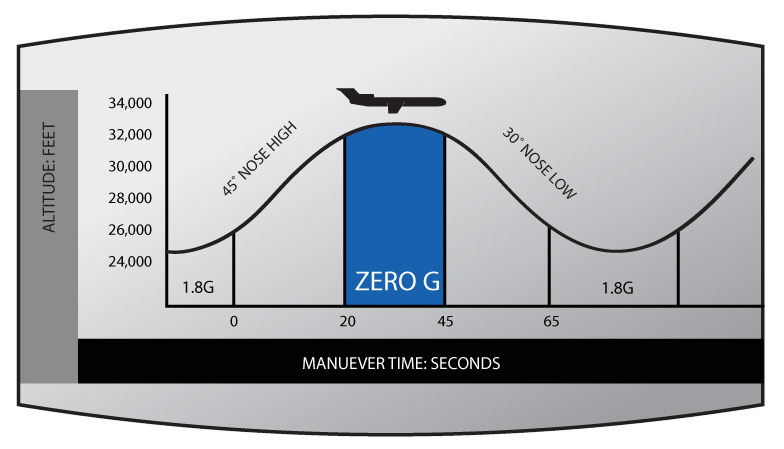
Related videos: exploding ping pong balls and more gravity (or lack of it).
Thanks, @xraydj.
Kristin JosephsonCool!
According to the research, “a wet animal could spend 20% or more of it’s daily food energy to evaporate water in its fur, if it cannot shake.” Therefore, it’s super important to get dry! Earth Unplugged’s Sam and Simon slow down this phenomenon of mammals shaking to get dry — super slow-mo style — in this sixth episode by BBC Earth Productions.
via Laughing Squid.
Kristin JosephsonWicked. Via Philly.
From the team that brought you Dark Sky, an app that has saved (or at least kept dry) my bacon more times than I can count, comes Forecast, a weather web site that incorporates several of the features that made Dark Sky great. From the announcement:
Tags: weatherRather than cram these things into Dark Sky, we decided to do something grander: create our own full-featured weather service from scratch, complete with 7-day forecasts that cover the whole world, beautiful weather visualizations, and a time machine for exploring the weather in the past and far future. You can access it from all of your devices, whether it be your laptop, iPhone, Android phone, or tablet.
On top of all that, we're providing this data to other developers, in the hopes that a truly independent weather community can thrive in the era of increasing corporate consolidation.
I’m certainly partial to science on Tumblr, because … well, I’m biased, and Tumblr is better :) But over on Facebook, pages like I Fucking Love Science are daily reminding millions of people how awesome it is to discover how the world works (or at least that science memes apparently never get old). Earlier this week, the world “found out” that the creator of that page “turned out” to be a woman, when Elise Andrew posted a link to her new Twitter account.
You can probably guess what happened next. To everyone’s dismay and no one’s surprise, most of the 1,000+ comments on that post expressed surprise that a popular page was published by a woman. Many of them took it a step further, calling her a “babe” and saying “damn that’s hot” and “sexy and smart!”.
Listen, it’s 2013. The world is not gender neutral, and Elise being a woman matters in some ways. I mean, imagine if the fact that a page like that is run by a woman motivates other young women to pay attention to science or gives them pride in their intellectual abilities. That’s awesome. But every time someone expresses surprise that a woman could do it, or mentions their looks in the same breath as their accomplishments … it’s one step forward and one step back, and here we are spinning our wheels instead of driving into the future. Everyone needs to call this kind of stuff out when they see it.
I know this because I have been the guy making those comments to some women at other points in my life. I didn’t understand why what I was saying or staring at or equating was hurtful or sexist, much less completely ineffective in terms of looking cool in front of women. But people talked to me, and I learned. Now I’m trying to be an ally, forever imperfect, but trying to help others achieve what they deserve. We can all do that.
Biological gender (which doesn’t even begin to get into gender identity) is nothing more than everyone’s random lot in drawing one of two chromosomal combinations (there’s actually more than that, but you get the point) from their parents. It doesn’t make anyone smarter, more capable, prettier, uglier, softer, tougher or sciencier than anyone else.
Anyway, go follow Elise on Twitter and tell her you’ve got her back. It takes an army to change things like this, and we science folks need to stand up for one another!
Kristin JosephsonI love this. Also, I love Pat's books; start with The Name of the Wind.
So I wasn’t going to do a Valentine’s Day post. Partly because I’m busy. And partly because I could really give a fuck. And partly because I’m a contrary person by my very nature.
But some things have happened today that have made me think about the nature of love. And that is something I’m interested in.
And if by odd coincidence this post happens to be timely…. Well, I suppose I can stand being timely once in my life.
* * *
Weeks ago, I was reading a book with Oot. At some point in the story, the characters go to the Doctor, and the doctor shows them what’s inside their bodies.
Oot’s curious about that stuff. It’s a cool teachable moment, so we take a break from the story to talk about our guts.
I point, “That’s a stomach. Do you know what that’s for?”
He knows. He tells me.
I point again, “Those are your lungs. Do you know what they do?”
He does.
Next I point at a picture of the circulatory system, “That’s a heart. Do know what that is for?”
He thinks about it for a long moment, then he lights up. “That’s where you keep all of your Love!”
* * *
Days ago I fell asleep with Oot on my lap.
Lately I’ve been keeping odd hours. I’m trying to get a lot of writing done and that means I don’t sleep as much as usual.
It also means I don’t spend as much time at home as I’d like. I write at the work house where there’s less distraction. Everyone working there knows if they bother me while I’m writing, I’ll fire them.
When I’m behind on writing, like I am now, it’s not uncommon for me to sleep at the workhouse too. I have a mattress there, I get food delivered. It’s not odd for me to spend several days there without leaving when I’m in the thick of it.
Still, I make a point of spending at least an hour or two every day with Oot. Sometimes Sarah brings him to visit me, sometimes I come home and visit him.
So a couple of days ago, I was sitting in the living room with Oot cuddled up in my lap. He’s not a particularly cuddly child, so these times are rare.
That said, I’ve stacked the deck a bit by offering to give him a massage. He loves having his back rubbed.
This is a sort of love, you realize. The negotiation of desires.
Oot desires the animal joy of having his back rubbed. I desire the animal joy of holding my warm child. These are not mutually exclusive. We can both get what we want here.
Would I prefer it if he would *just* cuddle me? Sure. That would be lovely. But we’re not living in a perfect world. He is a little boy, not a dog. He hasn’t been bred for 10,000 years to be a obsequious lap-sitter. So compromise is key. You have to give a little to get a little.
Our little arrangement reminds me of several of my college relationships. And some of my non-relationships too. Backrubs as currency. This is a skill I posses, and I have bartered it in the past. Sometimes just for the pleasure of touching another human in an intimate way.
The importance of touch should not be ignored. It shouldn’t be played down or viewed as something low or base. They joy of touching and being touched it is a big part of being human.
And while it is certainly not all of love, it is a type of love. It is a facet in the fractured glass of affection.
But as I’ve said, I haven’t been sleeping much lately. So, sitting there with my child in my lap, I started to nod.
Eyes closed, I hear Sarah come into the room and say, “Daddy is falling asleep. Do you want to help me put him to bed?”
“Oh, of course!” he says. Then he stands up and takes my hand to lead me.
This is an act of love.
Halfway through the living room he takes both my hands, which is probably meant to be twice as helpful, but it’s not. It means I have to bend down and take shuffling little steps.
So take little shuffling steps and bend down. I do this even though it hurts my back.
This too is love.
* * *
Hours Ago, I woke up.
My plan for today was to hurry over to the work house to get some writing in, then come back for my officially scheduled date with Sarah.
Our date is scheduled from noon to 2:00. It’s the only time we could arrange a sitter. The date is going to be short because Sarah is planning on making heart cookies for everyone she love. She and Oot are going to bake them, put people’s names on them, and hand deliver them on Valentine’s Day.
She’s been planning it for weeks. It’s it an expression of her love.
My thought is that we should reschedule our date. Pick a day she isn’t so busy. Pick a day when we could do something at night. At night, you see, the workhouse is empty. At night there are many uninhabited surfaces at the workhouse, and little chance of being overheard by our young child.
But Sarah wants a date on Valentine’s Day. It’s important to her. So noon.
I wake up at 7:30 AM, but when I go upstairs to check my e-mail, I hear Sarah calling. I head into her bedroom and she gives me the news. Oot got sick last night. Puking sick.
I look at him, he’s sleeping. Sweet as anything. Between him and the bed is a carefully placed towel.
“No cookies today?” I say.
Sarah shakes her head. “I didn’t sleep much last night. We’re going to stay in and have a quiet day.”
“That’s as it should be,” I say.
“We’re out of Pedialite,”
For those of you who don’t have kids, Pedialite is like Gatorade if your sport of choice is shitting and puking all over. It’s easy on your stomach, and has all sorts of important electrolytes you need if you’re losing a lot of fluid. Every parent should have several jugs of it on the pantry shelf.
But we’ve burned through our supply, so I get dressed and go brush snow off the car.
At the store I pick up some Campbell’s chicken and stars soup, because that’s what my mom fed me when I had an upset tummy as a kid. I pick up some string cheese, because Oot likes it. And I pick up some olives stuffed with garlic because if this is a flu bug, having some garlic in my system will help me fight it off.
Then I go get the Pedialite. One orange and one purple, so that he has a choice.
In the kid isle at the grocery store, I see that they don’t stock baby formula on the shelves anymore. Now they have little cards there. You have to take the card to the service desk to get the formula.
To me, this means people must have been stealing baby formula. And standing there at 8:00 in the morning, the fact that people have to steal formula for their babies just breaks my heart. That shows that something is fucked up in our society. Food for your babies should be a given, and if some people are having to steal it, it means that something has gone wrong in my little town. I’ll have to talk to some people and see what we can do about this.
This, you have to realize, is also love. Love is a small thing only if we force it to be small. It isn’t some commodity we hoard and dole out sparingly for family and friends.
No. When you see a broken car by the side of the road and stop to help the person. That’s love. When you watch the news and hear about kids being exposed to lead in playgrounds and frac mining fucking up the environment, the anger you feel actually comes from love. It means you care about people even though you don’t know them.
It’s a hard way to live your life. It means you’ll be feel helpless a lot, and you’ll be hurt a lot, and you’ll be angry at the state of things so constantly that it will rub you raw. But it’s the best way to be. It’s the only way civilization can function properly. It’s the only way we can make things better.
On my way out of the store I walk past the floral department. I ignored it on my way into the store because I was on a mission. But now I remember that it is Valentine’s Day. And while I could give a damn about flowers, Sarah likes them.
So I pick out some roses. And the very act of it makes me grit my teeth. Roses on Valentine’s Day. It’s such a cliche.
There’s a line, a half dozen men. This just reinforces the fact that I’m being a culture zombie and it raises my irritation exponentially. Plus this is thirty dollars that’s going to end up in the compost in two weeks. I could do a hundred more practical things with this money. Formula for kids. A hive of honeybees for Heifer International….
Then I see an old guy in line ahead of me. He’s gotta be 85 if he’s a day, and he looks like what I imagine when Garrison Keillor describes the old Norwegian bachelor farmers in lake Woebegone. He’s beautiful in his own way.
He’s got a dozen roses, and seeing him there warms my bitter old heart.
One of the guys in front of me (a guy in a red flannel, probably in his sixties) motions the older man ahead of him in the line. He says, “You go ahead, Ed. I’ve got plenty of time.”
The guy in the red flannel drops back and smiles at me. He says, “Ed there comes by here every week. Buys flowers for his wife.”
“That’s great,” I say, smiling like the idiot I am.
And it is great. This is someone who has made a habit out of love. There is something to be learned here.
So I pick up more roses. One of each color. Because this isn’t about me. For Sarah, love is a song. Love is words. Love is gifts.
That is not my way. For me, love is doing. Love is service. Love is caring for someone and tending to their well being.
This is a problem we have been struggling with for a long time: how the two of us show our love in different ways. It has led to many problems. Many fights. It is a terrible thing to be unloved. But in many ways it is worse to be loved and feel unloved.
Love is actually easy. We are all of us wired for it. We are full of love, even though sometimes we are barely aware of it.
Showing love is the hard part. Our culture poisons us constantly, telling us what we *should* love. Religions spout off about who we *can* love. Media lies to us, telling us *how* to love. For when you care enough to send the very best. Say it with flowers. Every kiss begins with Kay.
It’s hard to break away from that cultural conditioning. But it’s even harder for me to realize that sometimes, Sarah doesn’t want me to take care of her. She doesn’t need tending. Sometimes she just wants me to say that I love her and tell her she’s pretty.
So I bring home roses and soup. I scrap my plans to hole up and write today so I can be near my family and tend to them. Because that is what’s important to me. Whether or not they realize it, this is how I love.
Oot picks the purple Pedialite. He’s listless and just wants to stay in bed. He’s snuggled up with Sarah. She gets more cuddling than me, and I’d be lying if I said I wasn’t jealous.
But when I lay down he snuggles me too. No bribery needed.
When Sarah comes downstairs she sees the flowers and laughs and smiles. It’s a response that I would never have to flowers. We talk a little. I tell her I love her. I tell her she’s pretty.
Later, if Oot is feeling up to it, I will read him a chapter of the Hobbit. It’s the one where the goblins catch them in the mountains.
And through all of this, in bits and pieces, I write down these musings for you. Because I cannot help but tell stories. Because these things are important to me.
Because…
pat
Kristin JosephsonScience is awesome.

Planck-in’ on Billions and Billions
I’m amazed that in 2013, we can still be smacked upside the head and reminded of how little we know about our universe. Even the most basic things about it. Like, how old it is.
The European Space Agency’s Planck space telescope has collected 15.5 months worth of data on the Cosmic Microwave Background, or CMB (What’s that? Click here), and today they released the most detailed map ever of those oldest remnants of the Big Bang. It says that our universe is almost perfect. Almost.
The highlights from this new map include the finding that the universe is almost certainly 13.81 billion years old, about 100 million years older than previous estimates. And we got better estimates for the stuffness of stuff: 4.9 percent normal matter, 26.8 percent dark matter, and 68.3 percent dark energy. The universe is expanding, which is the whole reason that the CMB even exists, but this new map says it’s expanding slower than we thought.
The coolest part, though? The “almost perfect” part. The radiation that became the CMB was just sort of randomly splattered out, like we’d expect (and the randomness of the dots on the map above show that). But those little fluctuations aren’t the same everywhere! The universe appears to be slightly lopsided, and even rather cold in one part. The ESA folks say we may need “new physics” to explain why. Nice to know you cosmologists of the future will have something to work on :)
Of course, all of this just goes for the observable universe. The rest, whatever it may be (or not be), has NO EDGE. Just like Hank Green reminds us. Phil Plait has tons more dirty details behind the Planck news at Bad Astronomy.

Zach Weiner of SMBC Comics fame just tweeted out the most beautifully nerdy string of “Yo mama” jokes I’ve ever seen.
Kristin Josephsonvia Rodin
Yesterday Google announced that panoramic Street View imagery is now available for four of the world’s great mountains: Everest, Kilimanjaro, Aconcagua, and Mount Elbrus. The mountains are four of the Seven Summits—the highest mountains in each of the seven continents. Google employees captured the imagery on a series of mountaineering expeditions using a lightweight tripod and camera setup that is normally used in the company’s Business Photos program. As part of the expeditions they also captured beautiful panoramic imagery of the surrounding areas. See this Wired gallery for more photos from the project.
A typographical character is simply a printed symbol—this includes letters, numbers, and punctuation marks. The ? is called a question mark; ( and ) are called parentheses; and ; is known as the semicolon. But you know that already, and I suspect you’re beginning to wonder how one could possibly wring drops of “fascinating” from the dry towel of typography. And that’s fair. But did you know the division sign has a name? What about the mysterious origins of the paragraph sign? Where did the % sign come from? ¿Why on Earth do Spanish-speakers put those upside-down question marks at the beginning of their sentences? Read on!
10 The Pilcrow—¶
The pilcrow, also less elegantly called the “paragraph mark,” serves a number of purposes, most of which involve denoting the presence or location of a paragraph in one way or another. Most commonly, it’s used in word processing programs to indicate a “carriage return” “control character;” that is to say, a non-permanent mark showing where a paragraph ends. There is disagreement over the origin of the name; The Oxford English Dictionary, for one, likes to think it comes from a string of corruptions of the word “paragraph.” I prefer to side with the Oxford Universal Dictionary, which suggests that the sign itself looks a lot like a featherless crow—a “pulled crow.” The symbol itself derives from the letter C—you can still see it in there—which stood for the Latin “capitulum,” or “chapter.” The two lines that ended up vertically crossing the C were a sort of editorial note from the writer.
The pilcrow was used in the Middle Ages, in an earlier form, as a way of marking a new train of thought before the paragraph became the standard way of accomplishing this. Now, among its myriad uses are in academic writing (when citing from an HTML page), legal texts (when citing a specific paragraph), and in proofreading (an indication that a paragraph should be split in two).
9 The Ampersand—&
The ampersand is a logogram used to mean “and.” The symbol itself is based on a shorthand version of the Latin word for “and”—et—and in certain fonts, you can still clearly see an ‘e’ and a ‘t’ linked together (Adobe Caslon, for instance). The word ampersand has a somewhat unusual origin—it’s a corruption of the hard-to-parse, multilingual (English and Latin) phrase “& per se and,” which means “& by itself is ‘and.’” Confused? Don’t worry—that’s only natural. All it means is: “The symbol &, all by its little self, simply means and.” And where did this phrase come from? Well, in the early 1800s, & was considered the 27th letter of the English alphabet, and since saying “X, Y, Z, and” would be confusing, “and per se and” was said instead. It doesn’t take a major stretch of the imagination to fathom how this could quickly turn into ampersand, which it did by around 1837.
Because people like to make up urban legends based on everything, including stodgy ol’ typographical marks, there’s a vicious rumor floating around that French physicist and mathematician André-Marie Ampère used the mark so much that it eventually got called “Ampere’s and.” Don’t believe it for a second. In the end we’re left with a pretty little symbol that has more than a few variants.
8 Interrobang—!?, ?!, or ‽
What?! You’ve never heard of the interrobang!? Really? Well, now you have, so all is forgiven. An interrobang is described as a “nonstandard punctuation mark” (it’s part of the punctuation counterculture), used to end sentences where you really want both the exclamation point and the question mark. While the use of both marks side by side had been prevalent for some time, it wasn’t until 1962 when an advertising executive named Martin K. Speckter decided that enough was enough—no longer would he withstand the tyranny of two separate punctuation marks when one would suffice. He asked readers to suggest names—rejecting such fine ideas as rhet, exclarotive, and exclamaquest—and ultimately settled upon interrobang, a combination of the Latin root “interro” (think “interrogate”), and “bang,” which is printer’s slang for the exclamation mark. The word is used to describe both the two side by side (!? or ?!), or the combined symbol ?.
7 At Sign—@
What we know as @ has a lot of different monikers—including “at sign,” “at symbol,” “ampersat,” and “apetail”—but is unusual in that it doesn’t have a widely-accepted name in English. In Spanish, it is known as an arroba, and in French the arobase. @ has two primary usages—its original one, used in commerce to mean “at the rate of,” and more recently, “directed at” (primarily in email and in social media like Twitter). It has been claimed (by Italian professor Giorgio Stabile) that the symbol is actually over 500 years old, to represent an “amphora”—a unit of capacity used in commerce. It first made its way onto a typewriter as early as 1885, and has since found its way into our hearts.
A couple of fun facts:
- The Spanish arroba was a unit of weight equivalent to 25 pounds.
- The names for @ in other languages often derive from the idea that it looks like an animal. To wit: apenstaartje (Dutch for “monkey’s tail); papacy (Greek for “little duck); dalphaengi (Korean for “snail”); sobachka (Russian for “little dog”).

Guillemets are what the French use instead of quotation marks. In addition to the physical differences, the usage differs as well—generally, guillemets open and close entire conversations or exchanges, rather than individual utterances. Amusingly, the guillemet is named after a French printer named Guillaume Le Bé from the 16th century; “Guillemet” is a diminutive of “Guillaume.” One can only assume that French people call our quotation marks “Willies,” “li’l Bills,” or “Mini Williams.”

The Obelus, more commonly known as “the division sign” for reasons I can’t fathom, comes from an Ancient Greek word for a sharpened stick or other similar pointy object. It shares its roots with the word “obelisk.” The obelus was once used to denote sections of writing that were considered incorrect or suspicious; in other words, it would have been perfect for Wikipedia editors. It was first used to mean “division” in 1659 by Swiss mathematician Johann Rahn. While still used frequently in the US and in Britain, it is not commonly used to mean division in most of the rest of the world.
4 Inverted ? and !—¿ and ¡
In Spanish, when a sentence ends with a question mark or an exclamation point, it also starts with an inverted one. ¿Porque? Well, I’ll tell you porque. In 1754, the Spanish Royal Academy decided that the Spanish language had a dire problem: when you start reading a sentence, you often have no way of telling if it’s a question or not until you get to the very end.
Consider the sentence vas a ir a la tienda? (Are you going to go to the store?). Up until you get to the question mark, you are totally in the dark—is it a question, or simply a declarative sentence stating “you are going to go to the store”? In English, we have ways of indicating that a question is coming, so that proper inflection can be used, as well as to help with comprehension. In Spanish, you used to need contextual clues to help you out before the Royal Academy had its way. They also decided that the exclamation point would be lonely, so they advocated for its inverted use as well.
Though the language was slow to adopt this new convention, it is now a fully integrated part of the language. A few interesting usage notes:
- Short, unambiguous questions are often written without the inverted mark—Quien eres?
- In digital communication, the inverted mark is frequently left off (emails, instant messaging, texts).
- Some authors refuse to use inverted marks.
- Writers can get playful with the marks, including starting a sentence with a ¡ and ending it with a ?.
- ¿ can be used in the middle of a sentence if the whole sentence is not a question, but rather the final clause.
- Note that ¿ and ¡ are positioned differently than ? and !; they hang below the line.

File this under “things we use all the time but don’t know their name.” Ditto marks are those quotation-looking-guys you use to save your tired wrist from a few more seconds of writing, indicating that what’s directly above should be repeated. Though one might suspect (“one” being “me” before I researched it) that the word ditto may have been related to the Latin root “di” (meaning “two”, as in when you say “ditto” you mean “me too!”), it in fact derives from an early (c. 1620) form of the Italian word for “to say.” Originally, it was used to avoid needless repetition when writing a series of dates in the same month.
A “ditto mark” is a type of “iteration mark.” Other languages have their own, notably Chinese, Japanese, and Ancient Egyptian. It’s tough to fathom why Ancient Egyptian scribes might have needed a way to cut down on chiseling elaborate drawings into rock.
2 Percent Sign—%
Take a look at the percent sign. Look at each of the three individual marks—a circle, a line, a circle. Remind you of anything? Does it, perhaps, remind you of a certain number, with the digits rearranged and realigned? A very important number? Maybe . . . the number 100?
The % sign, of course, means that the preceding number should be understood as being divided by one hundred—”per cent.” The slash mark used to be straight across, with zeroes above and beneath, but it gradually became slanted—leading to what D.E. Smith, in 1925, called the “solidus form” of the percent sign. The solidus, aka slash, virgule, fraction bar, and other names, is this sign: /.
Because there is disagreement about everything, there is disagreement over whether there should be a space between the number and the % sign, over whether it should be per cent or percent, and when you should use the % symbol and when you should instead write out the word.
1 Upper Case and Lower Case letters
Once I learned the origins of the terms “upper case” and “lower case,” it seemed so obvious. I mused: does everyone know this but me? What else are my friends and family keeping from me? Instead, though, I decided to convince myself that legions of Listversers were in the dark like me, too embarrassed to say anything. Take comfort, fellow readers, for you may remain anonymous in your ignorance.
Now then: in the early days of printing, when each letter was set individually, the letters were kept in cases. The capital letters were kept in—you guessed it—the “upper case,” less convenient to the printer because of how relatively few capital letters are used, while the lower case letters were kept in the more accessible—wait for it—”lower case.” It’s as simple as that, really. This usage of the terms dates back to 1588.
Fun facts about cases:
- The use of two cases in a written language is called “bicameral script.” Languages with only one case are called “unicase.”
- So what were lower-case letters called before they used cases at all? Well, we have other words to describe them—Upper-case letters are called majuscules (and, of course, capitals), and lower-case letters are called minuscule. Note the spelling difference with the word miniscule.
The post 10 Fascinating Typographical Origins appeared first on Listverse.
Kristin JosephsonYes please!


Kristin JosephsonHere. I could live here. (also, testing commenting)
This small, off-grid, sustainable cabin on Ragged Island twenty miles from the coast of Maine was the brainchild of the owner’s architectural designer daughter, Alex Scott Porter, who designed the structure for her retired father, Bruce Porter, former professor at the Columbia University Graduate School of Journalism.
The exterior is clad in corrugated steel, with rolling storm shutters to cover the windows for when the blustery squalls so common to this region strike.
Thanks to the extremely remote location of the site, 90% of the materials and all of the work crew had to be shipped in, at significant expense, from the mainland 20 miles away.
The 480 square foot building (with an additional balcony bedroom) has water supplied by a rainwater catchment system which incorporates a mechanical roof washer feature: the first five gallons of rainwater during a downpour are discarded before any is allowed into the water storage tank. Then the water is drawn from the center of the tank to avoid any sediment that may have settled to the bottom or is floating on top.
Electricity is provided by four roof-mounted solar panels, that top up enough battery power to last a week. These batteries in turn supply most of the power to the cabin, including the DC operated Sunfrost fridge. Two appliances run off propane (the on demand water heater and the stove), which obviously have to rely on regular refilling trips to the two mile distant Matinicus Island.
Bathroom facilities include the aforementioned shower and a composting toilet.
Bruce said: “There was a general feeling that this house wasn’t going to work, but everything works great, just like a normal house!”
Alex estimates the cost of the five month project at around $175,000. Plans are available directly from her company at alexscottporterdesign.com. A significant portion of the cost was of course the transportation; she estimates a saving of $25,000 to $50,000 could be applied to more accessible locations.
Images by Eirick Johnson
Via Dwell and Inhabitat